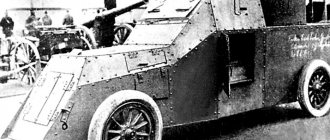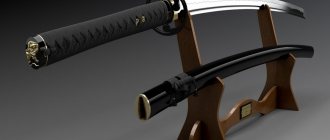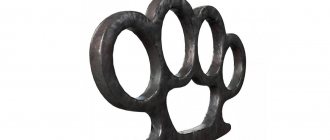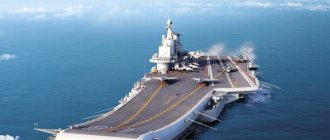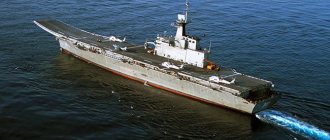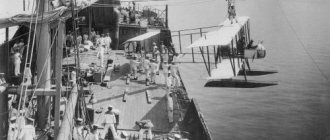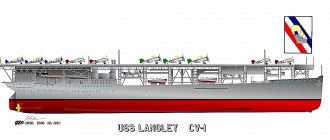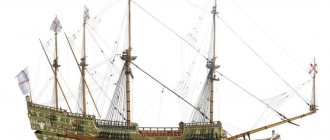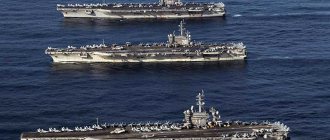How many aircraft carriers are there in the world?
At the moment, there are only 22 ships of this class in the world. Let's take a closer look at the current types:
- The United States ranks first in terms of the number of ships in service; it includes 11 aircraft carriers. As mentioned above, they consist of about 1000 aircraft, the length of each ship is from 250 to 331 meters, the speed is from 31 knots, the crew of each ship is from 2000 to 5000 people.
- Next in terms of the number of aircraft carriers are Italy and Spain - they each have 2 weapons;
- Third place is occupied by countries that have one such vessel each. These are Russia, China, Brazil, France, Thailand, India and the UK.
Russia is armed with one heavy aircraft-carrying cruiser, the Admiral Kuznetsov, with a displacement of 70,500 tons and a length of 304 meters. The vessel has 24 aircraft and 42 helicopters, and its speed reaches 32 knots.
Number by country
- USA (11 ships) - Ford type (1 ship Gerald R. Ford) - in service since May 2022. Production started in 2005, 8 years later it was launched, followed by testing and completion. The predecessor of this ship was the legendary Enterprise, which served for over 40 years and participated in many military missions carried out by America. It is now the largest aircraft-carrying cruiser in the world, costing approximately $13 billion to build—appropriately, Gerald R. Ford is also the most expensive aircraft carrier in the world. Nimitz class (10 ships) - ships with a nuclear reactor, also owned by the United States. In 1975, the first copy was put into operation, and by 2009 the tenth. Ships of this class were widely used in armed conflicts in the former Yugoslavia and Iraq. The cost of each such aircraft carrier cruiser is about 4.5 billion dollars.
- Italy (2 ships) - "Cavour" - has been in the fleet since 2007, has 8 aircraft and 12 helicopters on board, the length of the vessel is 244 m, the speed is 30 knots. Giusepe Garibaldi is another flagship of the Italian fleet, launched in 1983, has a length of 180 m, and a speed of 30 knots.
- India (1 ship) – The Indian aircraft carrier Vikramaditya was purchased from Russia in 2013. Former name "Admiral Gorshkov". The length is 274 m, the maximum speed is 32 knots, it can accommodate up to 20 aircraft and about 10 helicopters. In 2022 and 2023, two more aircraft-carrying cruisers are planned to be commissioned into the country's Navy.
- China (1 ship) – The Chinese aircraft carrier Liaoning was purchased from Ukraine in 2012 for $20 million. Former name "Varyag". Its length is 304 m, the aviation composition includes 24 fighters and 12 helicopters.
- Spain (2 ships) – The aircraft carrier Juan Carlos is in service with the Spanish Navy, has been in service since 2010, is 230m long, and is armed with up to 30 aircraft and helicopters.
- France (1 ship) – The nuclear-powered aircraft carrier Charles de Gaulle is the flagship of the French military. Commissioned in 2001, the dimensions are 261 m in length, and includes up to 40 aircraft.
- Brazil (1 ship) - "Sao Paulo" - aircraft carrier has been in operation since 2001, length 265 meters, includes 14 aircraft and 11 helicopters;
- Thailand (1 ship) - represented by the aircraft carrier Chakri Narubet - has the smallest size among existing analogues, the length is 182 meters, the aviation group consists of 14 aircraft and 12 helicopters. In operation since 1997.
- Great Britain (1 ship) - Illustrious class - one of the oldest active aircraft carriers, participated in the Second World War. Length 205 m, 33 aircraft in service. Currently, new aircraft carriers are being prepared for launch, which should replace the current one.
- Russia (1 ship) “Admiral Kuznetsov”, last on the list, but not in importance and power. Used since 1991, length 270m, number of aircraft: 50 planes and helicopters. Below we will look at it in more detail.
Specifications
Aircraft carriers are strategic ships and therefore detailed information about their design and set of technical characteristics cannot be found in the public domain. But some general information is still quite accessible to those interested.
The sizes of aircraft carriers vary in the following range:
- length - from 182 to 342 meters
- width - from 20 to 75 meters
- draft - up to 12 meters
- displacement - from 10,000 to 100,000 tons.
This variation in size is due to the fact that aircraft carriers are divided into four large classes depending on their strategic purpose:
- Supercarriers
or attack aircraft carriers are the largest among ships of this type and are full-fledged strategic multi-purpose vessels. - Multi-purpose or medium-sized aircraft carriers
are inferior to attack aircraft carriers in terms of air group size, aviation fuel reserves, combat survivability and autonomy, or in the range of functions performed. - Light aircraft carriers
, also known as aircraft carriers for vertical take-off and landing (VTOL) aircraft. Their military potential is significantly limited, but these ships are in service with many countries that do not have the resources to maintain larger aircraft carriers. - Universal landing ships
are amphibious helicopter carriers with a smooth flight deck and the ability to host a small VTOL support air group. The Mistral, recently acquired in France, also belongs to this class of ships.
Comparison of the best aircraft carriers in the world
Aircraft carrier cruiser Voryag
Let's look at ten of the most powerful and largest aircraft carriers in the world in the entire history of the existence of these ships. Let's look at each of them in more detail.
- Enterprise (USA) - this nuclear-powered large aircraft carrier rightfully takes first place. It was put into operation back in 1961, and over the next 50 years there was no replacement for this combat monster. In the mid-20th century, it was planned to build five more of the same ships, however, given the too high cost of the vessel, it was decided to leave it in a single copy. Thanks to nuclear fuel, it can remain autonomous in the ocean for up to 13 years. The largest aircraft carrier in the world has a length of 342.3 meters, can accommodate up to 80 aircraft, and has a crew of 3,000 people. The nuclear-powered ship includes four steam catapults, which make it possible to launch aircraft one after another in 15 seconds each. Four cables were installed on the runway to help the brake cylinders function. The ship is also equipped with a special nylon mesh, which, if problems arise when braking the aircraft, will be able to catch it and prevent an accident. The ship took part in the wars with Cuba, Vietnam and Iraq. In 2012, it was withdrawn from the US Navy. After another 5 years, the legendary aircraft carrier Enterprise was decommissioned. It was replaced by a new ship, the Gerald R. Ford, which plans to enter service with the US Navy by 2022. Before this period, the ship will make several trips to the open sea to confirm its combat readiness. The ship cost the country approximately $13 billion, making it the most expensive aircraft carrier in the world. In terms of its armament, the ship is no different from its predecessor, but it significantly exceeds it in terms of automation, which makes it possible to reduce the number of crew. New technologies were also used to ensure that the ship remained invisible when attempting to detect it using radar.
- Nimitz (USA) is another example of a nuclear-powered aircraft carrier; its first copy was produced in 1975. The production continued until 2009. Currently, the United States has 10 such ships in service. Its length is 330 meters. Such vessels were actively used during the war in Yugoslavia and Iraq. The cost of the ship is about 4.5 billion dollars. The nuclear reactor allows the ship to sail autonomously for about 25 years. The service life is 50 years.
- Kitty Hawk (USA) - the first such aircraft carrier was launched back in 1955. The length was 325 meters. Today, ships of this configuration are no longer in service with any country in the world. However, the ship still ranks third on the list of the largest aircraft carriers in the world.
- Forrestal (USA) - the length of the aircraft carrier is 320 meters, the specimen is known for the large number of fire-related accidents that occurred on board. As a result of one of these tragedies, 135 people burned to death. Removed from service in 1993.
- John F. Kennedy (USA) - the aircraft-carrying cruiser is also 320 meters in length; it was withdrawn from service with the US Navy in 2007. The ship served for about 40 years, carrying out missions mainly in the Mediterranean Sea. During his service he suffered several naval collisions.
- Midway (USA) - length is 305 meters, was produced in 1945, was the first heavy American aircraft carrier. Since 1992 it has been withdrawn from service and today serves as a fleet museum.
- Admiral Kuznetsov (USSR-RF) - the ship was built in the city of Nikolaev in 1985, today it is in service with the Northern Fleet of the Russian Navy, the length of the aircraft carrier cruiser is 300 meters.
- Lexington (USA) - a ship from the period of World War II, but in 1946 it was scuttled after nuclear tests were carried out with its help.
- Cruiser Varyag/Liaoning (USSR-Ukraine-China) - was launched in 1988 in Nikolaev. During the collapse of the Union, construction continued on board. Accordingly, the ship became the property of Ukraine, but repair work was stopped during this period. The unfinished aircraft carrier was subsequently sold to China for $20 million. Today it is in service with the Chinese Navy.
- Shinano (Japan) - was built in 1942 and took part in the war against America. The length of the ship was 266 m - until the end of the 50s of the last century it was the largest aircraft carrier in the world. In November 1944, during a battle with the American military, the ship was sunk, along with its 1,435 crew members.
The first aircraft carriers
First experience of taking off from a ship. The aircraft carrier is Birmingham.
The idea of an aircraft carrier was first described by the French inventor Clement Ader in the book “Military Aviation” at the beginning of the 20th century (in general, the French purchased aircraft for the army earlier than the United States, and at first they were ahead of all other countries in their views on naval aviation). Ader’s ideas were not pure theory; he was an outstanding inventor; he did a lot for the development of technology, including personally developing and producing several steam-powered aircraft. However, the technology of that time did not allow a more thorough approach to the study of this issue. At the same time, the very idea of providing aviation with even greater mobility by using the deck of a ship instead of a runway was widely promoted by the author and was accepted for development by many maritime departments around the world.
Do you know that…
...cruisers of the Svetlana class
They were laid down before the First World War, but they fought already in the Second.
The first "practical" step towards creating a real aircraft carrier was taken in the United States, which closely watched Orville Wright's first flights in Great Britain. Captain 2nd Rank F.L. Chapin, the chief observer, was so impressed by what he saw that he immediately proposed to his superiors that one of the new Connecticut-class ironclads be rebuilt so that Wright's aircraft could take off from it. However, his reports and ideas were met without enthusiasm.
However, when in the same 1908, another inventor, Glenn Curtiss, built his own plane, and two years later he created a real sensation by flying from Albany to New York in 2 hours 50 minutes, covering a distance of 142.5 miles. “The battles of the future will take place in the air. The airplane will decide the fate of nations,” was the headline of the NewYorkWorld newspaper that day.
And the restless Curtiss has already dealt a new blow to the positions of the old naval school - as if dropping several metal rods from his flying whatnot onto a raft in the lake. NewYorkWorld responded with lightning speed: “a plane worth several thousand can destroy a battleship worth many millions,” and naval officials (although not without resistance) were finally able to appreciate Captain Chapin’s idea and purchased the first plane “for military needs.”
Eli's plane lands on the deck of the Pennsylvania. The “braking” sandbags are clearly visible.
Of course, it was still too early to talk about the destruction of battleships by planes (as well as to utter the outlandish word “aircraft carrier”). In fact, even Wright’s “whatnot” purchased by the fleet did not at all abolish the stereotype that airplanes are just toys, not suitable for serious business. The navy was spurred on not by the desire to create a fundamentally new type of warship, but by the fear of being late. As it became known, the shipping company plans to purchase its own aircraft, and has already scheduled an amazing show for November 5, 1910 - from the Kaiserin Augusta-Victoria liner, using a special springboard, the airplane of pilot J.E.D. was supposed to take off. McCurdy. The purpose of the experiment was to “improve the work of the postal service,” but according to available information, the operation was secretly financed by the German Navy headquarters...
There was no time to hesitate. In record time, Captain Chambers was given all the powers, the materiel (including the light cruiser Birmingham, also with an improvised wooden “springboard”) and the order - by November 19, 1910 (something went wrong with the competitors and they the flight was postponed a little) to ensure the plane took off from the deck of the ship.
On November 14, Birmingham entered the Hampton Roads (Virginia) roadstead, accompanied by 4 destroyers. On its deck stood a Curtiss airplane (biplane) with a 50-horsepower engine, and a pilot named Eugene Ely sat at the helm.
Eugene Ely. The pilot not only made the first takeoff from an aircraft carrier, but also the first landing on it.
The flight was constantly delayed. At first there was no suitable wind, then it began to rain... by three o’clock in the afternoon no one believed in success, when the sky suddenly cleared and the command to start was sounded. Eugene was so afraid of missing out on the chance that, without even waiting for the Birmingham to pick up the anchor and pick up speed, he started the engine and the plane ran along the deck, jumped on the springboard and fell down... the height of 11 meters was barely enough for the pilot to level the car - the plane struck landing gear and propeller water and suddenly soared into the sky. The experiment was successfully completed.
However, it was necessary not only to take off, but also to land on ships, and this task was even more difficult. The same Chambers, after consultations with the pilots, made a proposal to use the armored cruiser Pennsylvania with a displacement of 13,680 tons for the experiment. A wooden platform was built at the stern of the ship, along the entire length of which 22 pairs of sandbags were placed. Each pair of bags was connected by a cable, and on the plane, in turn, 3 pairs of hooks were installed, which were supposed to cling to these cables when the plane passed over the deck. The design did not look very reliable, so at the end of the “strip” an additional tarpaulin was stretched, and lifeboats were on duty on the water.
On January 18, Eugene Ely took off from the San Francisco airfield and flew to the cruiser Pennsylvania, anchored in the bay. The plane flew over the Pennsylvania, descended far from the ship and began to approach it with a tailwind. The pilot aimed the plane directly at the stern of the cruiser and turned off the engine. Inertia and tailwind carried the plane over the first 11 brake lines. Then the hook grabbed one of the ropes, the plane ran 30 feet along the deck and froze. A second later, the entire deck erupted in deafening applause. Commander of the Pennsylvania, Captain 1st Rank K.F. Pond summed up the day with these words: “This is the most wonderful landing of a bird since the day the dove returned to the ark.” From now on, planes not only took off, but also landed on ships.
The skeptics were beaten at their own field. Now there was no end to the headquarters of those wishing to become a co-author of the “first real aircraft carrier.” It was even proposed to equip all large ships without exception with a take-off deck, and to organize a runway even on the roofs of battleship towers. However, it was already clear to specialists that neither cruisers nor battleships were suitable for organizing a serious air strike force; a completely new type of ship was needed... as well as aircraft.
There has not yet been any talk of creating a full-fledged aircraft carrier - a ship designed exclusively for organizing the take-off/landing of aircraft. The task of that period was somewhat different - how, with minimal alterations, to provide large ships with aircraft assigned to them, the main function of which was still only reconnaissance. The solution was found by the same Chambers - the plane was equipped with floats instead of wheels, takeoff and landing were carried out from the surface of the sea, after which the plane was lifted onto the ship by crane.
Already in February 1911, Glenn Curtiss boarded one such “hydroplane” off the side of the familiar Pennsylvania, was lifted aboard, and half an hour later was lowered back into the water, after which he flew away. Again, Chambers was successful - despite the cumbersome nature of the operation, for a single flight of a reconnaissance aircraft this method of landing (or rather, loading) was quite acceptable, and modifications to the ship were reduced to a minimum. The plane could simply be disassembled and folded until the next flight, so as not to clutter the deck.
Takeoff of the “whatnot” from the deck of the Pennsylvania
On July 1, 1911, the experiments were over - the first “combat” aircraft of the American fleet, the Curtiss A-1 seaplane, took off.
In 1914, the first baptism of fire of naval aviation took place - the battleship Mississippi and the light cruiser Birmingham with 5 hydroplanes of the Navy as part of the operation to occupy the Mexican port of Veracruz, they successfully used their aircraft for reconnaissance purposes.
Latest Developments
Admiral Kuznetsov
According to experts, one of the latest innovations in the Navy is the development of underwater aircraft of the Russian Federation. Russia's first nuclear-powered submarine aircraft carrier, Project 941-bis, is rumored to be ready by 2022. The idea of such a vessel has been developed since 1991 at the Rubinovsky project of transport submarines. Today on the Internet you can find a model of such a submarine. However, this submarine and its structure are strictly classified; it is not possible to find out the actual dates of commissioning. One thing is certain - if it is put into service, it will be the best aircraft carrier in the world and the only nuclear-powered submarine with fighters on board.
As can be seen from the list of the largest aircraft-carrying cruisers in the world of all time, the undeniable leading place in this type of weapons is occupied by US aircraft carriers. Aircraft carriers are an important attribute in the naval forces of any country, at the same time they are one of the most vulnerable ships in large-scale battles. Such ships are indispensable when conducting combat operations with countries that do not have modern nuclear weapons. In the event of aggression from a power of equal power, aircraft carriers will remain an important, but not the main component in conducting combat operations.
Fuel, speed, range
The maximum possible cruising speed that modern aircraft carriers are capable of developing is from 29 to 32 knots, which, translated into our usual units of measurement, is approximately 55 - 60 km/h.
The development of such speeds became possible thanks to the installation of nuclear power plants on ships. These installations make it possible to save displacement for aviation fuel and ammunition reserves. In addition, a nuclear power plant generates significantly more energy for ship catapults (this is especially important for aircraft carriers equipped with electromagnetic catapults).
Aircraft carriers represent a powerful strike force, but their effectiveness is much higher as part of a strike aircraft carrier group, which includes 1 strike aircraft carrier, 8-10 escort ships and support vessels.
The first material about aircraft carriers can be found here. Enjoy reading.
The death of "Langley"
The conversion was completed on February 26, 1937, and on April 11 the ship received a new designation - AV-3, ceasing to be an aircraft carrier. Langley was then transferred to the Pacific Fleet Reconnaissance Force, operated briefly in the Atlantic in 1939, and then went to the Philippines. Here in the Cavite base he met the beginning of the war.
Seaplane transport "Langley" at Pearl Harbor, July 29, 1938. collections.naval.aviation.museum
On December 8, 1941, the Langley left Cavite for the island of Balikpapan in the Dutch East Indies. On January 1, 1942, he arrived at the Australian port of Darwin, where he became part of the Allied Naval Forces (ABDA). Until January 11, planes from Langley conducted anti-submarine patrols, and then the air transport went to Fremantle, Australia, where it took on board 32 Curtiss P-40 Warhawk fighters from the 13th squadron of the American Far Eastern Aviation to transfer them to Cilacap (Java Island) ).
"Langley" in Darwin (Australia) before leaving for Perth, February 19, 1942. navsource.org
After this, the Langley and the Sea Beach transport, also loaded with fighters, joined the American-Australian convoy MS.5, which was traveling with troops and equipment to Ceylon. On February 22, both transports, together with the convoy, left Fremantle, and on the night of February 26-27, they separated from it and, accompanied by the destroyers Whipple and Edsall, headed for Chilachapu.
At 11:40, when about 75 miles remained to Cilacap, the small convoy was attacked by Japanese base aircraft - these were 16 twin-engine Mitsubishi G4M bombers from the Takao naval kokutai, led by Lieutenant Jiro Adachi and taking off from Denpasar airfield (Bali Island). . The bombers were covered by 15 A6M fighters.
The damaged and burning Langley, next to it is the destroyer Edsall. Photo taken from the destroyer Whipple. navsource.org
The main target of the Japanese was the Langley - its flight deck was clearly visible, so it was mistaken for an aircraft carrier. Horizontal bombers attacked from a medium altitude and from one direction, so the air transport managed to escape the first two attacks by desperate maneuvering. But the third attack was carried out from two directions: this time the ship received five bombs weighing 250 and 60 kg (possibly the latter were from fighters), as well as three close explosions. This happened at 12:12.
Sinking of the Langley. The photo was taken from the destroyer Whipple (it is usually mistakenly published as a mirror image). history.navy.mil
16 sailors were killed, the steering was damaged, and a fire broke out on the upper deck. Water began to flow into the compartments - gradually it flooded the engine room, and the Langley stopped. At 13:25 the order was given to abandon ship, and at about half past three the former aircraft carrier was sunk by two torpedoes from the escort destroyers. 485 people from Langley transferred to destroyers.
The death of the Langley. history.navy.mil
The destroyers brought the Sea Beach to Chilachapa, and then began guarding the Pecos tanker, which was sailing from Chilachapa to the Indian Ocean for fuel. Those rescued from the Langley were transferred to him; In total, about 700 sailors from sunken ships were on the tanker. Alas, two days later, near Christmas Island, the tanker, along with the Edsall, was sunk by Japanese dive bombers from the aircraft carriers Kaga, Hiryu and Soryu; the surviving Whipple managed to save only 232 people. Almost all the fighter pilots who were on the Langley were killed - 31 out of 33. The Sea Beach transport managed to get to Chilachapa and unload the planes there, but they soon had to be destroyed so that they would not remain with the Japanese.
Langley never saw action as an aircraft carrier, but she was killed in action by enemy naval aircraft and aircraft on board. This happened during the most difficult period for the American fleet, when enemy aircraft carriers dominated the sea.



